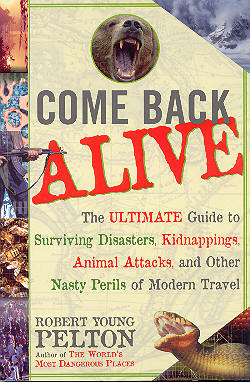Come Back Alive
Robert Young Pelton

So, you probably don’t want to eat at Pepe’s Mexican Restaurant and Used Tire Store. I don’t blame you; Tucson has many other dining establishments which are superior to that small eatery on Old Nogales Hwy. Food is one of the subjects covered by the author of this month’s literary selection, and while he might not choose to dine at Pepe’s, in the course of writing this book, he doubtless encountered meals that might not have rated even as highly as those served up along with the used tires. A scary thought, as you will see.
Come Back Alive: The ULTIMATE Guide to Surviving Disasters, Kidnappings, Animal Attacks, and Other Nasty Perils of Modern Travel is an engaging and cautionary tome, full of droll yet useful tips for the adventurous soul who chooses to travel beyond the bounds of the local mall and favorite eating places. Robert Young Pelton, also author of The World’s Most Dangerous Places, gives a whole new twist to cuisine in this passage from the chapter titled “Bush Eating” (and subtitled You Gonna Eat That or Raise it as a Pet?).
“There are some important questions you have to ask yourself before you read this chapter. Is it cool to eat things you used to dissect in biology class? Will your newfound love of herbage make you race the gardener for the lawn clippings every Wednesday? How do I tell my neighbor’s kid that I barbecued his hamster? Will the kids figure out those are deep-fried grasshoppers and not french fries? Will my fishing buddies get mad at me because I scarfed all the bait on the way up to the lake?
Survival eating is more about understanding what nutrition sources are available and overcoming cultural barriers. No, I don’t mean learning to enjoy ballet; I mean forcing yourself to eat things you would normally squash in disgust.”
Now, you may not ever want to find yourself in the position of having to consume the bait for sustenance, but no doubt there are folks who’d enjoy boasting about just how rough things got, and just how well they were able to handle it. The rest of us will just have to endure their cocktail party stories of survival. Here’s another passage from Come Back Alive, taken from the chapter called “Shelter” (and subtitled Home is Where You Left Your Dirty Underwear).
“You could say home is where you hang your hat. Others say home is where the heart is. I like to think that home is where you left your dirty laundry. A lot of hiking and travel is focused on covering distance. Campsites are just flat spots to cook some food, pitch a tent, and then move on. I think it’s because of this approach that we don’t really have any skills in adapting or building shelters.
The first reaction of most novice campers is to stick a tent right by the river or in a cleared area. There a beginners’ concept that a thin wall of nylon will protect them from marauding bears, mountain lions, and crazed woodpeckers. The only place this works is in Africa, where elephants won’t step directly on a tent and hyenas won’t tug on exposed hands or heads if they are in a tent. Or so they say.”
At any rate, Mr. Pelton’s guide gives comprehensive and fascinating advice for any traveler wishing to protect him or herself, whether sallying forth on a business trip, an African safari, a ski weekend, or just a brief jaunt to the corner store. No matter where you’re going, what you’re doing, or how dangerous you want to get, Come Back Alive could be essential to your safe and stylish return. Be sure to read all about it!
All Rights Reserved.